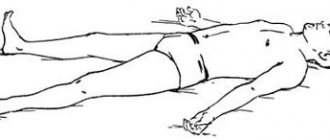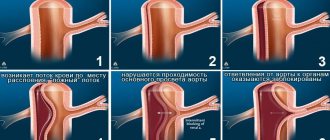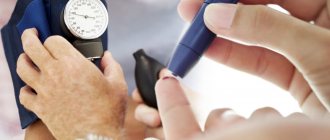Symptoms of hypertension
In some cases, for a long time, the only symptom of essential hypertension remains an increase in blood pressure.
It may be accompanied by nonspecific complaints of pain in the head (occurs in the morning, like a “heavy head”, localized in the occipital region), irritability, excessive fatigue, sleep disturbances, general weakness, dizziness, rapid heartbeat. A striking sign of the disease is considered to be hypertensive crises - short-term (from 1-2 hours to 2-3 days) exacerbations of the disease, manifested by a sudden increase in blood pressure. They occur in about a third of patients.
There are 2 types of crises in hypertension: first order (adrenal) and second order (noradrenal).
Hypertensive crisis of the first order develops more often in middle-aged people. A rise in blood pressure occurs at night and is accompanied by headache, chills, cold extremities, anxiety, restlessness, and rapid heartbeat.
Second-order hypertensive crisis is typical for older people. A rise in blood pressure is accompanied by severe headache, visual disturbances, lethargy, drowsiness, nausea, and vomiting.
With a long history of hypertension, the leading place in the clinical picture is occupied by symptoms of target organ diseases: chest pain with angina pectoris, shortness of breath, swelling with heart failure, symptoms of a stroke, etc.
Diagnosis of hypertension
In order to confirm a person’s diagnosis of hypertension, it is necessary to identify a persistent increase in blood pressure and exclude the presence of other diseases that are characterized by arterial hypertension syndrome.
An increase in blood pressure is determined using a conventional tonometer - blood pressure is measured by a doctor or the patient himself. An indispensable condition is compliance with the method of measuring blood pressure - the measurement is carried out after 3-5 minutes of rest in a comfortable environment, sitting, at rest, the shoulder and heart should be at the same level. Blood pressure level greater than or equal to 140/90 mm Hg. Art. indicates suspicion of essential hypertension. In diagnostically difficult cases, the technique of 24-hour blood pressure monitoring is used.
Exercise and hypertension
An increasing number of people are experiencing high blood pressure—about one in three adults. How can (and can) training help with this?
Data from the current and ongoing NHANE study: 85.7 million US residents aged 20 years and older have hypertension - that's 34% of the adult population. Available statistical data for Russia indicate that at least 40% of our population suffers from hypertension.
Moreover, hypertension now occurs even in children. According to guidelines released by the American Academy of Pediatrics in September 2021, 3.5% of current U.S. children and adolescents have hypertension. In the absence of rare diseases such as pheochromocytoma or renal failure, children should not have hypertension.
Things only get worse from there. The Framingham Heart Study identified the risk of developing hypertension in approximately 1,300 subjects aged 55 to 65 years who did not have high blood pressure at the time of follow-up: more than half of participants aged 55 years and about two-thirds of participants aged 65 years developed hypertension in over the next 10 years. The authors concluded that “ the lifetime risk of developing hypertension in middle-aged and elderly people is 90%!”
».
There needs to be better medical advice on the role of exercise - we're talking practical advice about exercise. Doctors are clearly not doing everything they can. What is meant here is the recommendation: “You need to exercise more. I instruct you to walk 30-45 minutes a day, 5 days a week, and please start today.” It’s sad to realize that such a conversation is a rare occurrence in medical practice. Doctors simply don't have the knowledge to give advice about exercise. It’s much easier to write out the required prescription and give a piece of paper with recommendations for yourself to review.
Can regular exercise prevent the development of hypertension?
- A study of Harvard University alumni over the years by Dr. Ralph Paffenbarger led to the following conclusions: Those who did not participate in active sports were 35% more likely to develop hypertension compared to those who exercised regularly.
No less significant is another conclusion:
it was intense training, and not training at an easy pace, that reduced the risk of developing hypertension throughout life
. In this case, “intensive” training included running, swimming, handball, skiing competitions, etc. - A study of Japanese men found that Walking for 20 minutes every day reduces the risk of future hypertension
.
- More recent data suggests that active rest totaling at least 4 hours per week reduces the risk of hypertension by 19%
.
Although the above may not apply to everyone, chances are good that regular exercise can actually prevent the development of hypertension.
"Normal" blood pressure
For many years, optimal blood pressure was considered to be 120/80 (systolic/diastolic). Medicines were prescribed for blood pressure of 140/90 and higher. When conducting the study, scientists calculated that with an increase in pressure from 115/75 to 185/115 mm Hg. Art. Each unit increase equal to 20/10 doubles the risk of cardiovascular events
, such as heart attack (myocardial infarction), heart failure, stroke and kidney disease.
People who engage in aerobic exercise tend to have lower resting blood pressure than those who are less physically fit
. This is not harmful and is not unusual. Improving adaptability to aerobic exercise leads to improved functioning of the circulatory system: the heart becomes stronger, it pumps more blood with each beat, and the body receives more oxygen from the blood.
A trained athlete consumes more oxygen than a sedentary person. The increased output of blood with each heartbeat, combined with higher oxygen consumption, results in lower resting blood pressure values and a slower heart rate.
The immediate effect of aerobic exercise on blood pressure
Research examining the effects of exercise on hypertension has been conducted since 1970, and many reviews (meta-analyses) of such studies have subsequently been published. But let's first define the difference between the immediate effect of a single workout on blood pressure and the long-term effect of regular exercise on hypertension.
When it comes to immediate effects, blood pressure can vary over a fairly wide range depending on the type of physical activity.
During aerobic exercise (intense endurance exercise - running, triathlon, swimming, skiing), the heart rate can rise to very high values, while the pressure usually remains fairly stable. However, abruptly stopping exercise, say after a long run, can lead to an equally dramatic drop in blood pressure.
The suspected cause of this phenomenon is blood flow to the legs (hence, less of it returning to the heart). This explains why some athletes feel dizzy after running long distances.
If you are familiar with this condition, here are some tips:
- Don't stop or sit down suddenly after finishing a long run, cyclocross, or tennis match, especially if you're noticeably sweaty.
- Continue walking at a leisurely pace for a few minutes.
- Massaging the leg muscles will also be helpful to normalize blood flow to the heart.
- If dizziness persists, lie on your back and elevate your legs.
- Drink more fluids and eat something salty - this will regulate the fluid balance in your circulatory system and have a positive effect on blood pressure.
The immediate effect of strength training on blood pressure
During truly intense anaerobic (strength) exercise, blood pressure can reach truly astronomical levels. For example, scientists measured that a bodybuilder performing a leg press had a brachial artery pressure of as much as 480/350.
Even a short-term increase in pressure to such values gives cause for concern. What happens to your heart and blood vessels in such cases?
Instant Effects of Various Types of Cardiac Exercises
Obviously, a high heart rate puts significant strain on the heart. The same applies to high blood pressure.
Both aerobic and anaerobic exercise put stress on the heart, but this happens for different reasons: during aerobic exercise, the heart rate increases to very high values, while the blood pressure increases slightly
.
Resistance exercise tends to have the opposite effect: a spike in blood pressure at a moderate heart rate
.
To compare the two mentioned types of physical activity, the so-called frequency-pressure coefficient (i.e., heart rate X blood pressure) is sometimes used. Note that in some cases the load on the heart when performing aerobic exercises may be higher than during strength training.
Aerobic training improves vascular elasticity
If you are in good physical shape, the positive effects are also noticeable on the blood vessels: the diameter of the heart arteries increases, it becomes possible to counteract the negative effects of atherosclerosis, and the ability of the arteries to dilate also improves. All this is called the term “increased vascular elasticity”, which is achieved by increasing the efficiency of the circulatory system as a result of regular aerobic exercise.
For example, runners and swimmers have better elasticity of the cervical arteries compared to people accustomed to a sedentary lifestyle. According to the study, older men with diagnosed hypertension experienced an average reduction in systolic blood pressure of 9 units and an improvement in arterial elasticity of 21% following a 12-week swimming program.
These are the results you should strive for!
In another study, in which participants walked/ran 5 times a week for 3 months, the pressure remained at the same level, but the scientists noted a restoration of the ability of the arteries to expand in the participants
.
Obviously, aerobic exercise has a positive effect on your blood vessels, even if standard blood pressure measurements show no improvement.
However, prolonged exposure to increased pressure on blood vessels during resistance training can lead to deterioration of vascular elasticity.
Forceful - impairs the elasticity of blood vessels
Young people who have been involved in strength training for at least 12 months
who did not perform any aerobic exercise
demonstrated vascular elasticity 26% lower than that found in people with a sedentary lifestyle
.
Another similar study of men who performed anaerobic exercise for more than 2 years had 30% lower vascular elasticity
.
Let's add data from a third study - in it, the subjects took part in a 4-month strength training program, before and after which their vascular elasticity was measured. The result is a 20% deterioration in the indicator after 2 months of classes.
.
What leads to such consequences? It is clear that artery walls respond in a specific way to extremely high blood pressure during strength training. They become stronger, yes, but also tougher. Despite the protective nature of this response mechanism, this situation cannot be called positive. The vessels must be as elastic as possible in order to narrow and expand if necessary.
These studies suggest that arterial elasticity increases with aerobic exercise and may decrease with anaerobic exercise. Adding to the concern is the fact that changes in a negative direction are not always noticeable by standard pressure measurements.
At the same time , new research data are emerging indicating a possible higher benefit of anaerobic training for hypertension
compared to established beliefs.
Now, many experts in the field of medicine are of the opinion that strength training is highly effective on its own
, while in the past such exercises always occupied second place in importance after aerobic exercises.
Vascular training program
So, how can you create a training program that does not harm the elasticity of blood vessels?
Of course, no one advises completely abandoning anaerobic training. All people, especially older people, should do weight-bearing exercises.
Here are 3 recommendations that it would be wise to follow, regardless of whether you have hypertension or not.
1. If you only perform weight training exercises, then stick to an intensity equal to 70% of your one-repetition maximum (1RM).
Research findings suggest that when performing anaerobic exercise with heavy weights, vascular elasticity suffers. An analysis of 8 studies found that arterial elasticity actually worsened when participants performed repetitions of 70% or more of their 1RM.
.
At the same time, more modest values of weights within 40-70% of the maximum did not cause negative changes.
The study, which included 35 elderly Korean men, found that vascular elasticity improved (albeit slightly) after resistance training. Yes, the subjects trained 5 times a week for a year, but the intensity of the training could hardly be called high: the weights were kept within 60% of the one-repetition maximum
. And in general, we are talking about older people!
The American Heart Association is even more conservative: people with hypertension should train at 30-60% of their maximum resistance.
. For example, if your maximum in the bench press is 50 kg per rep, then the working weight during training should be in the range of 15-30 kg.
2. Do not perform more than 1-2 approaches
The studies mentioned showed that resistance training at 50% of maximum still reduced vascular elasticity by 20% when performing 3 sets of each exercise
. Therefore, limit yourself to 1-2 approaches, regardless of the training weight, or do not forget to perform aerobic exercises.
3. If you are training with a weight greater than 70% of your maximum, include aerobic exercise in your weekly training program
The study findings suggest that training at 80% of 1RM did not impair vascular elasticity when subjected to regular aerobic exercise. In one study, participants performed 3 sets with a weight of 80% of the maximum, i.e. we can say that the training program was quite intense. However, when included in the program of aerobic exercise with a frequency of 3 times a week, no negative effects were noted on the elasticity of the arteries
.
- People with hypertension should not avoid weight-bearing exercise. However, if you are a fan of this type of training, limit your weights to low to moderate levels. And add aerobic exercise to your training program.
In the same case, if you have hypertension and you decide to do only one type of exercise, give preference to aerobic training.
Long-term effects of exercise on hypertension
Until very recently , there was consensus that aerobic exercise was better for people with hypertension than anaerobic exercise.
A 2013 review of 93 studies found that aerobic training was superior to resistance training for lowering blood pressure in hypertensive patients. The average reduction in blood pressure in patients with hypertension during aerobic exercise is an average of 8/5 (systolic/diastolic) points, and during anaerobic exercise there is a slight decrease, close to zero.
A large review published in 2002 showed the effectiveness of aerobic exercise in lowering blood pressure not only in patients with hypertension, but also in people with normal blood pressure, obese people and people of normal weight. The average reduction in blood pressure was 3.9/2.6 (systolic/diastolic). When analyzing exclusively hypertensive patients, the average pressure reduction was 4.9/3.7.
Data from a Japanese study are even more impressive: performing aerobic exercise achieved a reduction in blood pressure of as much as 20/10 (systolic/diastolic) after 20 weeks.
Let's take a closer look at the types of aerobic exercises and their effect on blood pressure.
Running and hypertension
In a University of Florida study, 101 of 105 participants with hypertension were able to lower their blood pressure by running 2 miles (about 3.2 km) daily for 3 months.
.
A study in Germany included 10 middle-aged men who took part in a running program lasting 3 years. They ran 60 minutes a day, 2 times a week, with a target heart rate of 60-70% of the established maximum, depending on age. As a result, after 3 years, systolic pressure decreased by 16 units, diastolic - by 15
. By the way, not all medications to lower blood pressure have the same pronounced effect.
The conclusion of one of the doctors (Paul Williams, PhD) states that the runners he examined reduced the amount of medications they took for hypertension with a gradual increase in weekly running distance and corresponding positive changes in the activity of the cardiovascular system. A study from the University of Florida showed more impressive results: 24 out of 105 patients with hypertension completely stopped taking pills while sticking to a daily running program.
Cycling and hypertension
In one study, participants rode an exercise bike 3 days a week for 20 weeks. The training intensity was initially set to “moderate” (55% of VO2MAX) for 30 minutes and was subsequently increased to “vigorous” (75% of VO2MAX) for 50 minutes per day. However, at the end of the study, the decrease in participants' blood pressure was not significant (less than 1 point for both systolic and diastolic). This result, however, does not mean that cycling is useless to lower blood pressure. In this study, participants' baseline blood pressure readings were not significantly elevated, providing a likely explanation for the small effect.
Another study in Japan found that moderate-intensity cycling (50% of VO2MAX) 60 minutes a day, 3 days a week for 20 weeks reduced blood pressure by more than 20/10 units.
(systolic/diastolic).
Swimming and hypertension
Swimming is an ideal activity for people with knee or hip pain, as well as for those who for some reason cannot walk or run quickly. At the moment, there are not many studies that would evaluate the effect of swimming to lower blood pressure, but the available data indicate quite high effectiveness.
One study from the University of Texas at Austin involved adults 50 years of age and younger who had hypertension but were not taking any blood pressure pills. After completing a 12-week swimming program, there was a 9-point reduction in systolic blood pressure and a 21% improvement in cervical artery compliance.
.
How intense should aerobic training be?
When it comes to preventing the development of hypertension as you age, the previously mentioned study involving Harvard graduates showed the benefit of high-intensity training compared to a moderate pace. But what if you already have hypertension? Should aerobic exercise be equally intense in this case?
In one study, sedentary people completed an aerobic training program lasting 45 minutes a day at an intensity of 70-85% of their individual maximum effort. The exercises themselves, performed 3-4 times a week for 6 weeks, included cycling, running or brisk walking. At the end of the program, the subjects showed a decrease in systolic and diastolic pressure by 6 units.
Without a doubt, this is a good result, but not everyone can do training with such a load. Will there be an effect from less intense exercise?
It turns out that even regular walking helps lower blood pressure.
.
In one study, researchers concluded that after regular walking for 25 weeks, blood pressure decreased by 3/2 units (systolic/diastolic)
. Other studies showed more impressive results:
- In a study of postmenopausal women that included walking 3 kilometers every day for a total of 24 weeks, the resulting decrease in systolic pressure was 6 units.
In general, we can say that absolutely all types of aerobic exercise have a positive effect on reducing blood pressure.
The effectiveness of anaerobic exercise
As mentioned earlier, most studies have concluded that aerobic exercise lowers blood pressure more than anaerobic exercise.
However, in 2012, Brazilian researchers recorded a decrease in systolic and diastolic blood pressure of 16 and 12 units, respectively, after participants completed a 12-week training program with a load of 60% of 1RM. This result was much more noticeable than earlier findings. The only disadvantage of the study is the small number of subjects - only 15 people.
An extensive review of published studies released in 2016 only confirmed the findings of Brazilian experts. Its authors concluded that resistance exercise was as effective in lowering blood pressure as anaerobic exercise, and perhaps even more effective.
One 2021 study found that isolated anaerobic exercise (i.e., without accompanying aerobic exercise) reduced systolic and diastolic blood pressure by 8 and 4 units, respectively.
New research data is forcing experts to reconsider the role of strength training in the treatment of hypertension.
Official recommendations regarding exercise for people with hypertension
Although the first evidence of the effectiveness of exercise to combat hypertension appeared back in 1973, only recently has the medical community paid attention to the very idea of recommending exercise as a means of treating certain diseases.
Until 2002-2004, there was no consensus on which means of combating hypertension were most effective. Back then the emphasis was on aerobic exercise.
In 2002, the National High Blood Pressure Education Program recommended the following: "regular aerobic physical activity, such as brisk walking, for at least 30 minutes per day on most days of the week."
In 2004, the American College of Sports Medicine (ACSM) released a recommended exercise plan for those suffering from hypertension. It included 4 elements, represented by the acronym “FITT”: frequency, intensity, time, type.
Frequency:
You should exercise on most days of the week, ideally every day.
Intensity:
Moderate exercise intensity (40-60% of VO2MAX) is recommended.
Time:
The duration of classes should be at least 30 minutes per day. This can include either a single long workout or a sum of shorter periods of activity throughout the day.
Type:
Preference should be given to aerobic exercise, but you should not completely abandon anaerobic exercise.
- If we try to convey the entire meaning of the above recommendations in one sentence, we get something like this: Walk at a brisk pace for 30-45 minutes a day, 5-7 days a week.
.
However, we are talking about recommendations published in 2004. As discussed above, newer research shows that resistance training is no less effective than aerobic training for people with hypertension.
This led to experts being forced to change their recommendations. Linda Pescatello was the lead author of the 2004 ACSM guidelines. And in 2015, she and her colleagues released a paper called “Exercise for People with Hypertension: Updating Recommendations to Based on Recent Research.” This document still advises aerobic exercise, but states that patients should also include anaerobic exercise 2-3 times per week.
.
Who is not recommended for training?
Although exercise can be effective in treating hypertension, you should not start a new exercise program without first talking to your doctor, especially if you have any cardiovascular disease.
If you are currently taking medications to lower blood pressure, then, as a rule, intense exercise is contraindicated until your blood pressure drops to more acceptable values. It is especially important to follow this recommendation for older people and those whose blood pressure is assessed as very high.
Stop exercising if:
- Your resting blood pressure is greater than 200/110,
- During exercise, your blood pressure rises to 220/115 or higher.
If you experience chest pain during exercise, stop exercising immediately.
High Pressure Training: Conclusions
- To lower your blood pressure, the best option is a combination of exercise, healthy eating and, if you are overweight, losing weight.
- If you have high blood pressure or any cardiovascular disease, do not start high-intensity exercise without first consulting your doctor.
- Focus on aerobic exercise
.
When you reduce your blood pressure to lower values, incorporate anaerobic training into your program
. - Although intense aerobic exercise can be effective, moderate-paced exercise is also beneficial. Walking and cycling can successfully lower blood pressure. For older patients, especially those with knee or hip pain, swimming is recommended.
- If you are overweight or obese, lose weight.
- Switch to a plant-based diet. Not all people are able to reduce blood pressure solely through aerobic exercise. Combining this type of training with a healthy diet may be more effective.
Hypertension is a condition that usually persists throughout life. However, there is considerable evidence that regular exercise, combined with losing weight (if you are overweight) and limiting your salt intake, can reduce high blood pressure. Moreover, physical exercise successfully helps with other diseases of the cardiovascular system.
More importantly, these lifestyle changes can completely prevent the development of hypertension in the future.
.
Treatment of hypertension
In the treatment of primary hypertension, non-drug and drug methods, which complement each other, are successfully used.
Non-drug methods for treating arterial hypertension
Prescribed to absolutely all patients with hypertension, even if the person is receiving medications to control blood pressure. These measures involve eliminating risk factors by modifying a person’s established lifestyle and habits. Scientists have proven that non-drug treatment in certain cases is not inferior in effectiveness to drug treatment.
Main directions:
- limiting the amount of table salt supplied with food (up to 5-6 g per day). This implies a complete rejection of foods such as sausages, sausages, salty cheeses, canned foods, and salted fish. It should also be noted that a significant amount of salt is contained in baked goods;
- fight against excess weight - people suffering from primary hypertension are recommended to reduce the caloric content of their diet by limiting the consumption of fats;
- limiting the consumption of alcoholic beverages - up to 30 g of ethyl alcohol per day;
- complete and strict cessation of smoking - if necessary, seek the help of a narcologist;
- regular physical activity - moderate, preferably daily, lasting at least half an hour. Outdoor activities are preferred: jogging, brisk walking, cycling.
Rehabilitation for hypertension
Verbal self-suggestion
The patient’s body is controlled by the subconscious and considered health problems as the result of self-hypnosis and destructive imagination. Physiotherapy The main goal of physiotherapy is to induce reflex neurovascular responses that are beneficial to the healing process. For this purpose, magnetic therapy, infrared laser therapy, etc. are used. Only a doctor can select the appropriate method. Physiotherapy has a number of contraindications: blood clotting problems, cancer or third-degree hypertension. In some cases, physiotherapy is not indicated already at the second stage of the disease.
Massage
Massage sessions are recommended at all stages of hypertension, excluding periods of exacerbation. The goal is to normalize the functioning of the nervous system, improve hemodynamics, first of all, blood circulation in the brain and myocardium. For hypertension, massage of the upper back, neck, occipital region, scalp, and anterior chest is recommended. Use stroking and rubbing. In addition to the classic, reflex-segmental and acupressure massage is used.
Healing Fitness
Physical rehabilitation for hypertension involves at least minimal physical activity. Physical exercise improves the nutrition of cells in the tissues of the heart, increases coronary blood flow, and promotes the opening of reserve capillaries. This stimulates recovery processes in the heart muscle. Physical activity improves metabolism, promotes the burning of fat deposits, reduces cholesterol levels in the blood, inhibiting the development of atherosclerosis. To achieve a noticeable therapeutic effect, physical exercise must be performed at least three times a week.
Diet
Complete rehabilitation implies a qualitative change in the diet for hypertension. It should be compiled by a qualified nutritionist.
Drug therapy
Arterial hypertension cannot be cured with a short course of medication, such as an infectious cold or pneumonia. The drugs are prescribed in a continuous course for an indefinitely long time. Full recovery with medication alone is unrealistic. Medicines only suppress symptoms and protect against further complications. In order to be completely cured, a patient with hypertension should reconsider his entire lifestyle.







